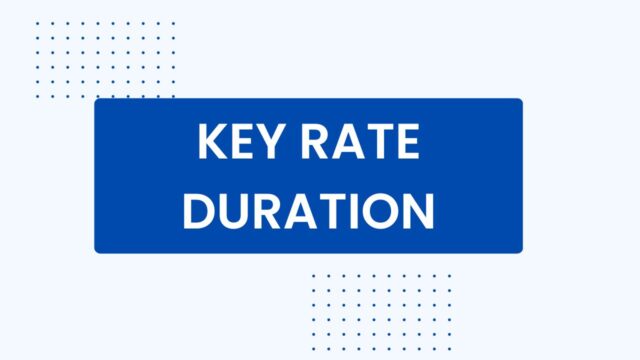
What is ‘Key Rate Duration’
The duration of an asset or portfolio at a certain maturity point throughout the whole yield curve is measured by the key rate duration. When all other maturities are held constant, the key rate duration may be used to determine how sensitive a bond’s price is to a one percent change in yield for a certain maturity.
Explaining ‘Key Rate Duration’
The concept of key rate duration is important in estimating the expected changes in value for a bond or portfolio of bonds because it does so when the yield curve shifts in a manner that is not perfectly parallel, which occurs frequently, and as a result, it can be used to estimate the expected changes in value. Effective duration, another important bond metric, is an insightful duration measure that calculates expected changes in price for a bond or portfolio of bonds given a 1 percent change in yield. However, it is only valid for parallel shifts in the yield curve, which makes it a less useful duration measure. This is why the critical rate duration measure is so useful.
Interest rate sensitivity
A measure of interest rate sensitivity is the modified duration (DV01), and this is the same for options as it is for bonds. For example, if you invest in a bond with a put option embedded, the price cannot fall below $1,000 before maturity. The sensitivity of the bond to interest rate changes is lower than the sensitivity of a non-puttable bond. Similarly, a puttable bond will not fall below $1,000, even if the interest rate decreases and the price increases.
Interest rate sensitivity can be measured using both effective duration and key rate duration. A bond with an effective duration of nine years and a key rate duration of eleven years would lose 11% of its value if interest rates rose 1%. Another way to determine interest rate sensitivity is to look at a particular corporate bond with a two-year duration and a maturity of six months. If interest rates fell by 0.5%, the price of the bond would rise 1.25%.
The effective duration, on the other hand, only applies when the changes in interest rates and the yield curve are parallel. This is because the interest rates for different bond maturities rarely increase or decrease in the same amount. Short-term bonds would decline by 1%, and long-term bonds would increase by 1%. The key rate duration is therefore more relevant in the long-run. Therefore, investors should calculate the key rate duration for each bond maturity that they hold.
Bond price sensitivity
The term “bond price sensitivity to key rate duration” means how sensitive the bond’s price is to changes in the yield of a benchmark interest rate. In simple terms, it indicates how much the bond’s price would change if the yield on the benchmark interest rate were to change 1%. However, key rate duration is less useful for short-term investments, because the duration of a bond is not the same for different maturities.
When it comes to measuring interest rate sensitivity, DV01 or modified duration is an excellent option. Bonds with an embedded put option have a shorter duration. This type of bond is essentially zero-coupon, so its price can never fall below $1,000. As a result, the term of a bond is a good proxy for its price sensitivity to key rates. In other words, if the bond price falls below $1,000, the put option would void the option and no more money is lent out.
The key rate duration is also a useful tool for determining the maturities of bonds. By comparing their durations, investors can identify which bonds are more sensitive to key rate changes. The length of a bond is measured in basis points. This means that it can withstand a range of interest rates and yield changes. However, there are some limitations to using this metric. For instance, when a change in yield is large, key rate duration is misleading and an effective measure is more useful.
Bond price sensitivity to a 100 basis point change in yield
The sensitivity of a bond’s price to a change in yield is measured by examining the amount of volatility of its price in response to changes in its required yield. This volatility is generally the same whether the required yield increases or decreases by one basis point. Bond prices and yields are inversely related. Factors such as face value, yield to maturity, and coupon rate determine the sensitivity of a bond’s price to changes in the required yield.
The sensitivity of a bond’s price to a 100-basis-point change in yield is based on two metrics: modified duration (MDL) and duration (DV01). The term’modified duration’ is used to describe the sensitivity of a bond’s price versus changes in its yield. An embedded put option allows the owner to redeem the bond before it matures for $1,000. In this case, the price of the bond will never fall below $1,000.
The Macaulay duration is the most commonly used measure of sensitivity. This measure is the % change in the price of a bond for every 100 basis points change in the yield. The duration of a bond, also called its maturity, is important for investors because it helps determine the risk and price volatility associated with the security. The longer the duration, the higher the risk and volatility of a bond’s price.


































